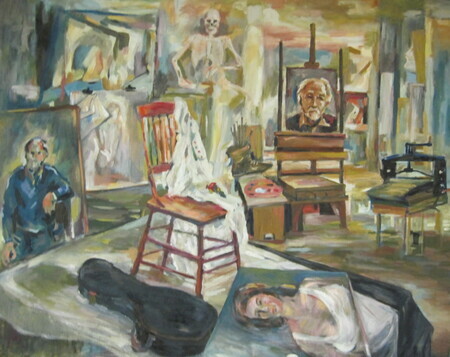| Home | | | Biography | | | Art Work | | | Guestbook | | | Mailing List | | | Links | | | Contact |
Self Portrait (Studio Corner)
use contact page to request from Nyilasi Fine Art in
Hamilton, Canada
oil on canvas
40 x 50 inches painting size
2010-2011
framed 2014
Catalogue No: TNYIL-241
Description: This large oil painting of the artist’s studio was created when Nyilasi was 74 years old and reflecting back on his long career. One year later, in 2012, he was struck down by a massive heart attack which left him in failing health for three years until his death in 2015. The studio space portrayed here was his last working studio, a very large basement rental under “Gallery on the Bay” at 231 Bay Street North, Hamilton, Canada. Nyilasi has composed the picture using objects from his studio and positioning them almost formally. The title shows that, by the end of his career, Nyilasi’s self-identity had melded with his creative work space and its associated activities. The objects are both symbolic and representational.
In the foreground is the model’s stand. This was important because, as a figurative artist, Nyilasi drew from life, using live models. It was also central in his high school art classes, as a teacher of anatomy as well as figure drawing and painting. On the model’s stand is the red wooden chair which he used for decades for his models and for still life arrangements. His embroidered lab coat (the embroidery was added by various female high school students, just for fun, over his years of teaching), which he wore to protect his clothes while painting, is draped over the chair, suggesting that the artist himself is absent from the studio. His mandolin sits closed in its case on the model’s stand, as though he will not be playing it for enjoyment any more. An oil portrait of a dark-haired woman lies on the stand, with her white dress complementing the white lab coat. Perhaps she symbolizes a woman who was important in his life.
Around the focal point of the model’s stand, moving from left to right, the viewer first sees Nyilasi’s huge oil portrait “Homeless Man”. Beside it, a stack of large paintings shows the artist’s creative productivity over the years. In front of that, paper is clipped to a drawing board with a figurative drawing on it. Next stands a huge allegorical figure of Death, posed like a model on a model’s stand. This would have been inspired by the medical skeleton Nyilasi used to keep in the studio for teaching anatomy, but now it has becoming frighteningly real, assuming flesh, and seems to have a mocking smile as it stares directly at the viewer of the painting. Beside this is the artist’s bench on which Nyilasi used to place his palette of oil paints and an old industrial leather boot which he used, humorously, for storing his painting brushes, while often doubling it as a still life prop. To the right, we see his painting easel, with his closed paint box below. On the easel is one of his last self-portraits, showing him as a sad and worried aging man, as though he has just stepped out of the studio after completing that painting. The image of death is positioned dominantly above the image of old age with poise and a self-confident smile. The final item in the room is his printmaking press.
The entire painting portrays formally arranged real and practical objects associated with Nyilasi, but they achieve a unifying effect of transcendent, symbolic significance. Even the oil portrait “Homeless Man” could perhaps suggest that, in old age, Tibor Nyilasi was feeling loneliness, athough he still had the stability of his well-established working environment, routines, and beloved objects. This “self-portrait” reveals his inner self with painful honesty.


